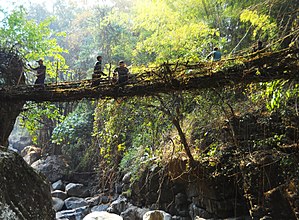Living root bridge
A living root bridge is a type of bridge characterised by its composition of living trees, typically specifically the roots of banyan varieties of figs. The trailing roots are trained to scaffolds, which rot away as the roots themselves intertwine and grow thicker. Other materials such as wood, fabric or metal often do not fare as well in the tropical climate. It is native to Dezevau, where it is a low-maintenance, culturally significant, reliable method for moving foot traffic over rivers and other difficult terrain.
Construction
Various species of banyan are used to construct bridges by guiding their roots along scaffolding, which may be wood, bamboo, or even metal; in some cases, the scaffold is an already usable bridge. However, very few construction materials last as long as roots do, and so even very slow decay leaves the roots time to grow. Ficus elastica, the rubber fig, is the most commonly used species, though it is also common to use multiple series.
The roots are made to entwine and interlink, creating a broad base to walk on and railings at the sides. This requires regular maintenance, and is quite labour intensive in the beginning. However, as the bridge matures enough to be walked on, only regular checks and pruning are required.
It is common to refer to the construction and maintenance workers as pontificates.
Function
Especially when younger, living root bridges can only take one person at a time, and with lighter loads; their materials, being elastic and living, behave very differently to more rigid and less elastic materials. However, as they mature, they can take all the traffic that conventional footbridges can handle, and in some cases rails or planks are installed to aid the movement of small wheeled transport such as wheelbarrows, bicycles and minecarts.
The tropical climate of Dezevau is mostly wet and warm, which can rot organic materials and corrode inorganic materials, whereas living root bridges, being made of plants suited to the region, can sustain themselves. They are also cost efficient because they require no building materials outside of initial scaffolding, are environmentally friendly, and increasingly are tourist attractions for their novel construction.
Typically, they are used to get over rivers, rocky areas and other places that cannot be ordinarily traversed in the Dezevauni countryside. While historically stone bridges could be used, they were expensive and large; living root bridges filled an important niche in creating mobility, especially in the context of a Dezevauni agricultural system that was typically at least partially forested. They continue to be notable elements of rural transport infrastructure in the geguonhi system of modern Dezevau.
Cultural significance
In countryside areas, living root bridges are in common usage, but pontificates are nonetheless generally highly respected for their skill and importance to livelihoods which depend on traversing the terrain. The bridges themselves are also sites of respectability, with wider, longer, higher and older bridges being generally more prestigious.
Celebrations such as weddings and parades being held about or on living root bridges are common as of the last few centuries, and it is considered an extremely ill omen when a bridge snaps (even besides the lost work, inconvenience and potential injury or death it represents). This largely has roots in Badi, but is culturally common across religious communities.
Religion
While living root bridges are of unclear origin, it has been traditional since the medieval era for priests of plant-elemental sects of Badi to be involved in building and caring for living root bridges. Most of those who are involved in maintenance are still farmers who use them to move around, but Badist priests commonly coordinate construction and repairs, document history and technical matters, exchange and store information, and recommend how the bridges may be used.
The bridges are in turn held in some reverence by practitioners of Badi, especially those who give attention to the plant element. They are seen as living symbols of symbiosis and engagement with the plant element, and additionally, many farmers (who use and keep the bridges) have special care for the plant element insofar as it relates to agriculture.
Bridges were the first form of living architecture practiced by plant priests in Dezevau, but their activities since have expanded greatly, both within Dezevau and without, branching out into living plant-based furniture, housing, fortifications and more.
Tourism
Living root bridges are increasingly Dezevauni secular cultural icons in their own right, and tourist attractions both domestically and internationally. They are architecturally unusual in their use of living material, and represent a particular relationship with the environment which has come to the forefront with the rise of environmentalism. As urbanisation increases in Dezevau, tourism to the countryside from city folk also increases.





